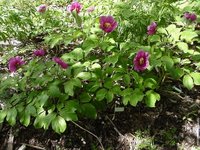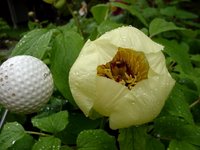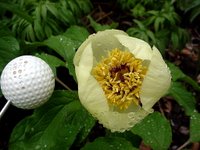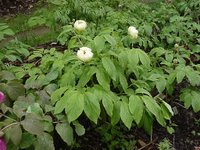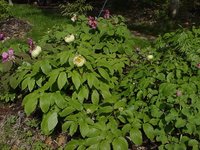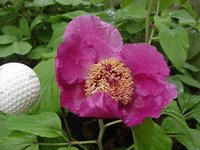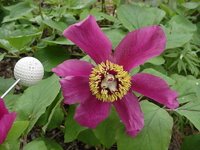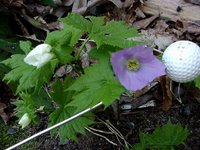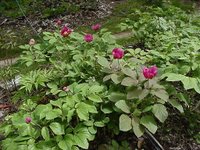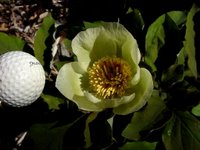 This is one of my favourite species (they are all favourites, so this is saying either a lot or not much!). The foliage in particular is very unique in that the leaflets, which occur in 3 sets of 3, are twisting or undulating. They are a pleasant soft green
This is one of my favourite species (they are all favourites, so this is saying either a lot or not much!). The foliage in particular is very unique in that the leaflets, which occur in 3 sets of 3, are twisting or undulating. They are a pleasant soft green  right from the time of emerging, and carry their distinctiveness throughout the growing season, waxy in appearance and with a soft blue tint in some light conditions.
right from the time of emerging, and carry their distinctiveness throughout the growing season, waxy in appearance and with a soft blue tint in some light conditions.Some botanists include Paeonia triternata
 as a synonym of Paeonia daurica subsp daurica, which is also considered a synonym for yesterday's subject, P caucasica. Check the photos yourself and decide if they are horticulturally distinct. Oh yeah. The only obvious similarity to me is that both have leaflets arranged in 3 3's. It also has the synonym Paeonia mascula subsp triternata. Anyways, enough of that for today; as usual I will stick to the name on the seedpacket.
as a synonym of Paeonia daurica subsp daurica, which is also considered a synonym for yesterday's subject, P caucasica. Check the photos yourself and decide if they are horticulturally distinct. Oh yeah. The only obvious similarity to me is that both have leaflets arranged in 3 3's. It also has the synonym Paeonia mascula subsp triternata. Anyways, enough of that for today; as usual I will stick to the name on the seedpacket.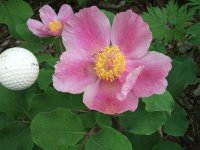 This second photo of the flower is a couple of days later than the first, and shows off the subtley ornate and beautiful radial striping on the petals. The colour stands out marvelously amongst the other pink to reddish species in concurrent bloom. First bloom here 28 May this year, 2 days earlier in the field and a day later in the woods.
This second photo of the flower is a couple of days later than the first, and shows off the subtley ornate and beautiful radial striping on the petals. The colour stands out marvelously amongst the other pink to reddish species in concurrent bloom. First bloom here 28 May this year, 2 days earlier in the field and a day later in the woods.This species is native to the Crimea and Turkey, where it grows in thickets and tending towards more moist sites. Here it is less vigorous than most species and is a smaller plant in my part shade bed and in the woodland. It's less happy in the open field although it has come into flower there a year later than in the shadier spots. But that could just be a moisture issue, since the field is dryish if not exactly dry.


